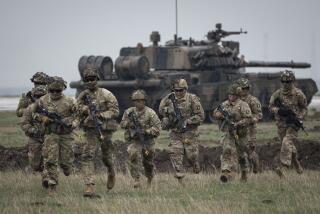Get Ready for a Ground War
- Share via
As Serbian forces ethnically cleanse Kosovo faster than NATO air power can limit their ability to do so, many are now arguing that the alliance must prepare to deploy ground forces. These advocates of a ground campaign are right: NATO will have failed badly if we do no more than punish Yugoslav President Slobodan Milosevic and “degrade” his forces while he kills thousands of ethnic Albanians and drives hundreds of thousands more from their homes.
Some, including Clinton administration officials, still believe that the allied air campaign can convince Milosevic to relent and agree to the Rambouillet peace plan. But they should study their Gulf War history, For example, in Desert Storm we needed more than a month to weaken Iraq’s Republican Guard armored forces by just 25%. That adds up to less than 1% attrition per day. At a similar rate, Serbian armed forces will have completed their evil designs in Kosovo long before NATO denies them the ability to do so. Even if we badly disrupt the supply lines that keep armor going, Serbia can hold off the KLA and do a fair amount of ethnic cleansing with mortars and other small weapons alone.
But what type of ground campaign should we undertake? In considering the use of ground forces, we need to recognize the following realities:
* American troops would have to lead this type of forcible intervention. European militaries do not have enough dedicated transport assets to move large numbers of troops over fairly large distances quickly. They are even more lacking in mobile logistics support such as equipment repair facilities, engineering units, mobile hospitals, supply trucks and the like. Europe as a whole put fewer than 50,000 troops on the ground in Desert Storm, even after a five-month buildup period, and could not do much better today.
Serbia’s military wields more than 100,000 active-duty troops. Prudent force planning suggests that NATO would itself need to deploy at least 100,000 troops into Kosovo. (Some believe a 2-1 advantage is necessary to prevail in combat, but U.S.-led forces did not have that in Desert Storm, and they do not need it here, either.) Since NATO Europe could provide no more than 50,000, the other 50,000 or more would have to be American.
* Even with a major American effort, it would take 10-14 days to get the vanguard of the NATO ground force into Kosovo itself and one to two weeks more to complete the deployment.
Some forces could move faster than that. For example, the 82nd Airborne Division’s ready brigade can be moved anywhere in the world within a day or two. And NATO’s 10,000 forces now in Macedonia, designed for rapid operations into Kosovo, could cross the border quickly. But the total of these forces, roughly 15,000, is probably inadequate to protect even a restricted safe haven in Kosovo. Some of NATO’s 30,000 forces in Bosnia might be available for combat in Kosovo. But they would have to traverse Serb-held Bosnia and then Montenegro--in other words, be prepared to fight through Serbian opposition. Moving a force that far--perhaps 200 to 300 miles--and in that region’s terrain would take time.
How would NATO build up additional forces in the region? Most likely, it would send strategic transport aircraft to Italy or Greece first, then unload them and ferry the supplies by smaller plane or helicopter into Macedonia. (Once a staging area was established in Kosovo, smaller planes could fly directly there from Italy or Greece.) NATO could also land equipment on Albanian shores, but would need weeks to move forces there by sea and days more to deploy into Kosovo.
* Casualties to NATO forces could be considerable. Serbia’s armed forces may be highly motivated to fight over land they see as the cradle of their civilization. NATO’s forces are much better than Serbia’s, but it would be imprudent, based on the precedents of Panama and Somalia, to assume many more than 10 Serb losses for every NATO casualty. If the Serbs were prepared to lose thousands of troops, we could lose hundreds.
* In the longer term, even if armed and trained by NATO, the KLA would probably need outside help. Drawing on a population base of only one-fifth that of Serbia, the odds would be against it in any future war.
Putting all these considerations together, NATO should prepare now for a possible ground invasion. For example, the United States could send lead elements of the 101st Air Assault Division to Italy immediately. At the same time, NATO should give Milosevich incentives to back down rather than order his forces to fight to the death.
So how do we do this? NATO should intervene to establish an independent Kosovo; it is absurd to think any longer that Kosovo Albanians would or should live under Belgrade’s rule. But NATO might convince them to put off a binding referendum on independence for three to five years to help Milosevic save face. More important, it should insist on a partition of Kosovo with Belgrade retaining permanent control over perhaps one-fourth of the province along its northern, eastern and southern edges. That is much less than Milosevic wants, but perhaps enough--when combined with a credible threat of a NATO ground invasion--to get him to buckle.
This realpolitik, carrot-and-stick approach may sound too muscular for some and too much like appeasement of Milosevic for others. But it stands the best chance of saving ethnic Albanian lives without eliciting staunch Serbian resistance to NATO or the need to keep American soldiers based in an independent Kosovo for years. Indeed, it might even induce Serbia to the negotiating table before the operation has to be carried out at all.
More to Read
Sign up for Essential California
The most important California stories and recommendations in your inbox every morning.
You may occasionally receive promotional content from the Los Angeles Times.













